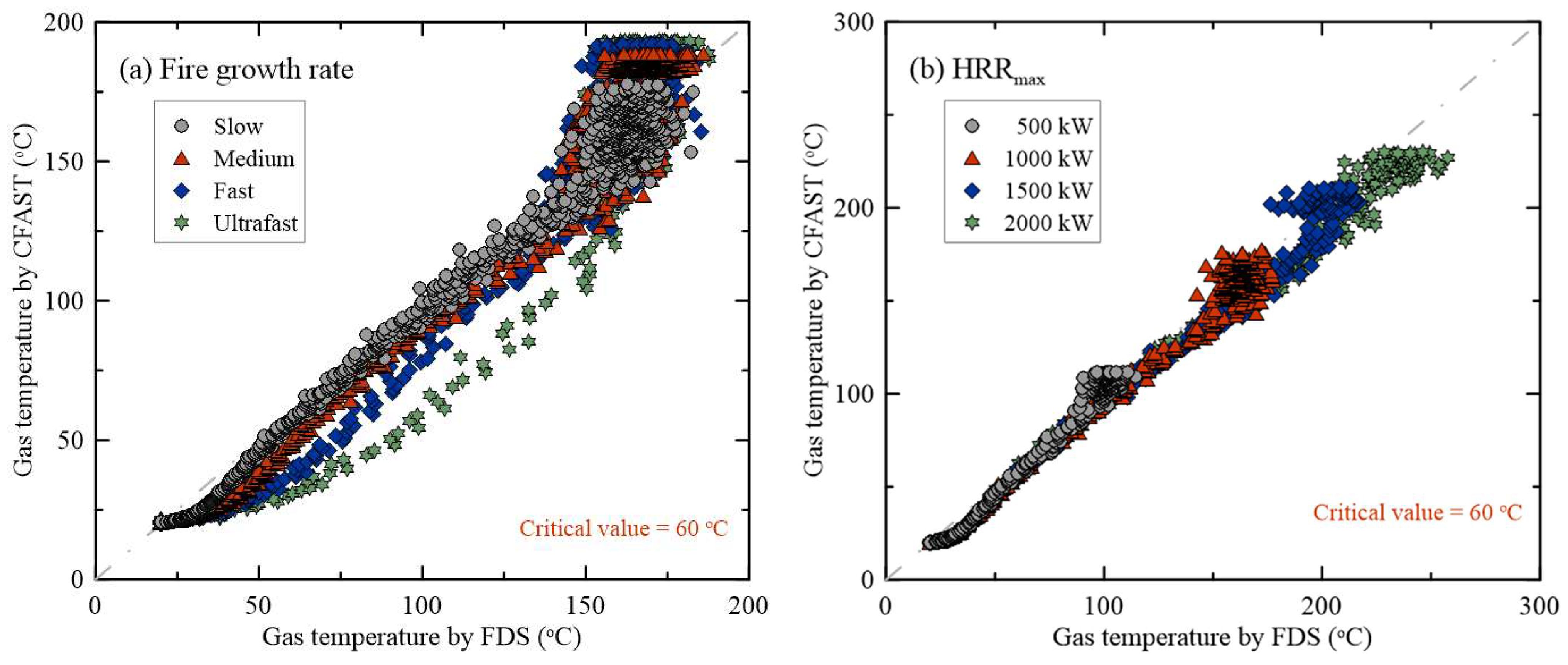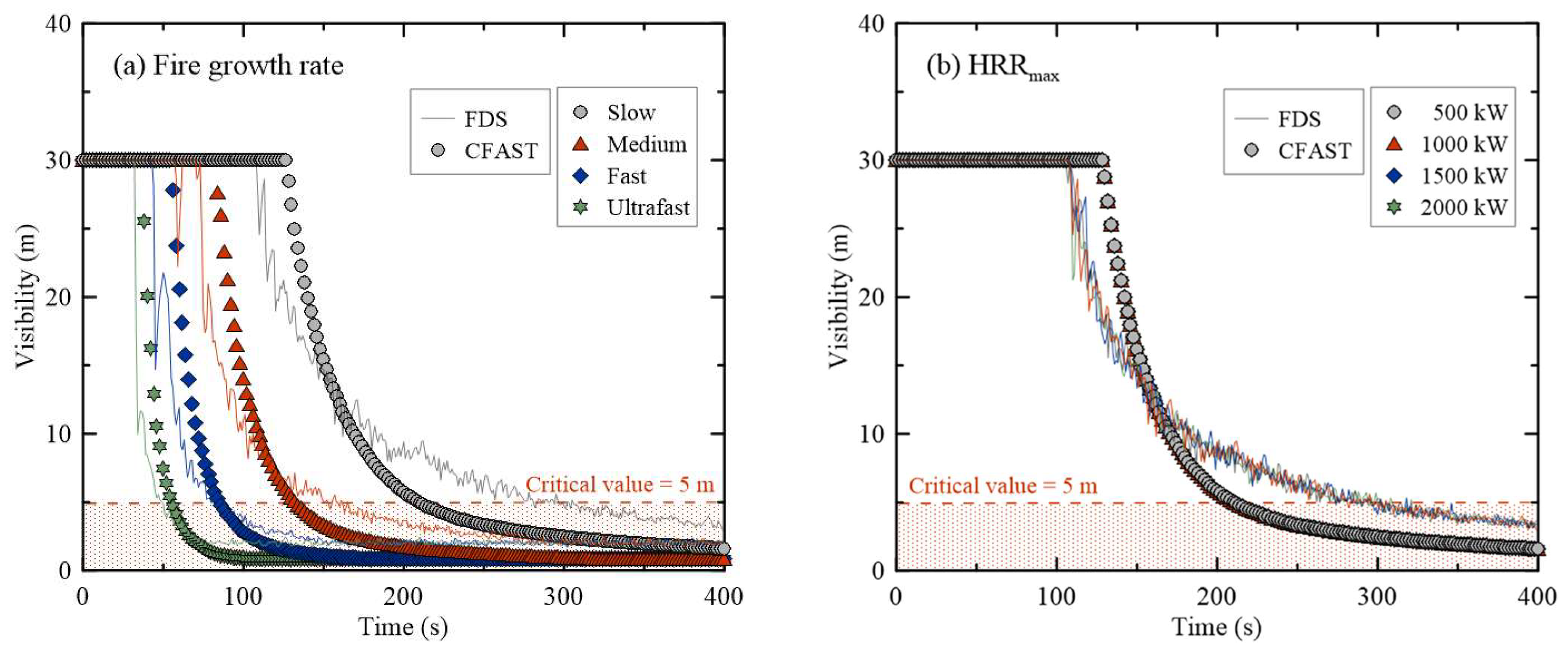Evaluation of Available Safety Egress Time (ASET) in Performance-Based Design (PBD) Using CFAST
Abstract
1. Introduction
2. Conditions and Methods for Fire Simulation
2.1. Fire Simulation Conditions
2.2. Fire Simulation Method
3. Results and Analysis
3.1. Prediction of ASET Evaluation Factors Based on Fire Models
3.2. Comparison of Predicted Results of Major ASET Evaluation Factors Using Fire Models
4. Conclusions
Author Contributions
Funding
Institutional Review Board Statement
Informed Consent Statement
Data Availability Statement
Conflicts of Interest
References
- McGuire, J.H.; Tamura, G.T. Simple analysis of smoke-flow problems in high buildings. Fire Technol. 1975, 11, 15–22. [Google Scholar] [CrossRef]
- McGrattan, K.; Hostikka, S.; McDermott, R.; Floyd, J.; Weinschenk, C.; Overholt, K. Fire Dynamics Simulator User’s Guide, NIST SP, 6th ed.; National Institute of Standards and Technology: Gaithersburg, MD, USA, 2015; Volume 1019. [Google Scholar]
- Peacock, R.D.; Reneke, P.A.; Forney, G.P. CFAST. Consolidated Fire and Smoke Transport: User’s Guide, NIST TN 1889v2, 7th ed.; National Institute of Standards and Technology: Gaithersburg, MD, USA, 2021; Volume 2. [Google Scholar]
- Thunderhead Engineering. Pathfinder User Manual; Thunderhead Engineering: Manhattan, KS, USA, 2020. [Google Scholar]
- IES Virtual Environment. Egress: Simulex User Guide; IES Virtual Environment: Glasgow, UK, 2015. [Google Scholar]
- Galea, E.R.; Lawrence, P.J.; Gwynne, S.; Filippidis, L.; Blackshields, D.; Cooney, D. buildingEXODUS v6.3 User Guide; GUEL Subsidiary of the University of Greenwich: London, UK, 2017. [Google Scholar]
- Korhonen, T.; Hostikka, S.; Heliovaara, S.; Ehtamo, H. ‘FDS+ Evac: An Agent Based Fire Evacuation Model.’ Pedestrian and Evacuation Dynamics 2008; Springer: Berlin/Heidelberg, Germany, 2010. [Google Scholar]
- Jang, H.Y.; Hwang, C.H. Revision of the input parameters for the prediction models of smoke detectors based on the FDS. Fire Sci. Eng. 2017, 31, 44–51. [Google Scholar] [CrossRef]
- National Fire Agency of Republic of Korea. Performance Based Design Methods and Standards on Fire-Fighting System Installation Act; National Fire Agency of Republic of Korea: Sejong, Republic of Korea, 2016; Volume 3-a, Annex 1. [Google Scholar]
- Ahn, S.H. Study on the Improvement of Performance-Based Design (PBD) through the Analysis of the Whole PBDs. Ph.D. Dissertation, The Graduate School of Daejeon University, Daejeon, Republic of Korea, 2018. [Google Scholar]
- Hsieh, H.R.; Chung, H.C.; Kawabata, N.; Seike, M.; Hasegawa, M.; Chien, S.W.; Shen, T.S. Assessment Method Integrating Visibility and Toxic Gas for Road Tunnel Fires Using 2D Maps for Identifying Risks in the Smoke Environment. Fire 2023, 6, 173. [Google Scholar] [CrossRef]
- McGrattan, K.; Hostikka, S.; McDermott, R.; Floyd, J.; Weinschenk, C.; Overholt, K. Fire Dynamic Simulator; Technical Reference Guide, NIST SP, 6th ed.; National Institute of Standards and Technology: Gaithersburg, MD, USA, 2015; Volume 1018-1. [Google Scholar]
- Brohez, S.; Caravita, I. Fire induced pressure in airthigh houses: Experiments and FDS validation. Fire Saf. J. 2020, 114, 103008. [Google Scholar] [CrossRef]
- NRC; EPRI. Verification and Validation of Selected Fire Models for Nuclear Power Plant Applications; NUREG-1824; EPRI 1011999 [Final Report]; United States Nuclear Regulatory Commission: Washington, DC, USA, 2007. [Google Scholar]
- Mun, S.Y.; Cho, J.H.; Hwang, C.H. Effects of external heat flux and exhaust flow rate on CO and soot yields of acrylic in a cone calorimeter. Appl. Sci. 2021, 11, 5942. [Google Scholar] [CrossRef]
- Acherar, L.; Wang, H.Y.; Coudour, B.; Garo, J.P. Assessment of Semi-Empirical Soot Modelling in Turbulent Buoyant Pool Fires from Various Fuels. Thermo 2023, 3, 424–442. [Google Scholar] [CrossRef]
- Kaczorek-Chrobak, K.; Fangrat, J. PVC-based copper electric wires under various fire conditions: Toxicity of fire effluents. Materials 2020, 13, 1111. [Google Scholar] [CrossRef] [PubMed]
- Jang, H.-Y.; Hwang, C.-H. Obscuration threshold database construction of smoke detectors for various combustibles. Sensors 2020, 20, 6272. [Google Scholar] [CrossRef] [PubMed]
- Yoon, G.Y.; Han, H.S.; Mun, S.Y.; Park, C.H.; Hwang, C.H. DB construction of activation temperature and response time index for domestic fixed-temperature heat detectors in ceiling jet flow. Fire Sci. Eng. 2020, 34, 35–42. [Google Scholar] [CrossRef]
- Peacock, R.D.; McGrattan, K.; Forney, G.P.; Reneke, P.A. CFAST Consolidated Fire and Smoke Transport: Technical Reference Guide, NIST TN 1889v1, 7th ed.; National Institute of Standards and Technology: Gaithersburg, MD, USA, 2021; Volume 1. [Google Scholar]
- Williamson, J.; Beyler, C.; Floyd, J. Validation of numerical simulations of compartment fires with forced or natural ventilation using the fire and smoke simulator (FSSIM), CFAST and FDS. Fire Saf. Sci. 2011, 10, 1277–1288. [Google Scholar] [CrossRef]
- Floyd, J. Comparison of CFAST and FDS for Fire Simulation with the HDR T51 and T52 Tests; United States Department of Commerce, Technology Administration, National Institute of Standards and Technology: Gaithersburg, MD, USA, 2002. [Google Scholar]
- Patterson, N.M. Assessing the Feasibility of Reducing the Grid Resolution in FDS Field Modelling; University of Canterbury: Christchurch, New Zealand, 2002. [Google Scholar]
- Oliva, D.; Somerkoski, B.; Tarkkanen, K.; Lehto, A.; Luimula, M. Virtual reality as a communication tool for fire safety—Experiences from the VirPa project. In Proceedings of the GamiFIN Conference 2019, Levi, Finland, 8–10 April 2019; pp. 241–252. [Google Scholar]
- Yun, H.S.; Hwang, C.H.; Choi, J.H. Evaluation of Predictive Performance of CFAST for Fire Characteristics in Single and Multi-storey Buildings. Trans. Korean Soc. Mech. Eng. B 2022, 46, 441–451. [Google Scholar] [CrossRef]
- Jang, H.-Y.; Hwang, C.-H. Configuration approaches of CFAST for prediction of smoke and heat detector activation times in corridor fires. Appl. Sci. 2023, 13, 13161. [Google Scholar] [CrossRef]
- National Fire Protection Association. NFPA 92 Standard for Smoke Control System; National Fire Protection Association: Quincy, MA, USA, 2012. [Google Scholar]
- Tewarson, A. Generation of heat and chemical compounds in fires. In SFPE Handbook of Fire Protection Engineering, 3rd ed.; DiNenno, P.J., Ed.; National Fire Protection Association: Quincy, MA, USA, 2002. [Google Scholar]
- Mulholland, G.W.; Croarkin, C. Specific extinction coefficient of flame generated smoke. Fire Mater. 2000, 24, 227–230. [Google Scholar] [CrossRef]
- Jin, T.; Yamada, T. Irritating effects of fire smoke on visibility. Fire Sci. Technol. 1985, 5, 79–90. [Google Scholar] [CrossRef]










| Parameter | Value |
|---|---|
| Gas temperature | Over 60 °C |
| O2 volume fraction | Under 15% |
| CO2 volume fraction | Over 5% |
| CO volume fraction | Over 1400 ppm |
| Visibility (for a light-reflecting object) | Under 5 m (other facility) |
Disclaimer/Publisher’s Note: The statements, opinions and data contained in all publications are solely those of the individual author(s) and contributor(s) and not of MDPI and/or the editor(s). MDPI and/or the editor(s) disclaim responsibility for any injury to people or property resulting from any ideas, methods, instructions or products referred to in the content. |
© 2024 by the authors. Licensee MDPI, Basel, Switzerland. This article is an open access article distributed under the terms and conditions of the Creative Commons Attribution (CC BY) license (https://creativecommons.org/licenses/by/4.0/).
Share and Cite
Jang, H.-Y.; Hwang, C.-H. Evaluation of Available Safety Egress Time (ASET) in Performance-Based Design (PBD) Using CFAST. Fire 2024, 7, 108. https://doi.org/10.3390/fire7040108
Jang H-Y, Hwang C-H. Evaluation of Available Safety Egress Time (ASET) in Performance-Based Design (PBD) Using CFAST. Fire. 2024; 7(4):108. https://doi.org/10.3390/fire7040108
Chicago/Turabian StyleJang, Hyo-Yeon, and Cheol-Hong Hwang. 2024. "Evaluation of Available Safety Egress Time (ASET) in Performance-Based Design (PBD) Using CFAST" Fire 7, no. 4: 108. https://doi.org/10.3390/fire7040108
APA StyleJang, H.-Y., & Hwang, C.-H. (2024). Evaluation of Available Safety Egress Time (ASET) in Performance-Based Design (PBD) Using CFAST. Fire, 7(4), 108. https://doi.org/10.3390/fire7040108







